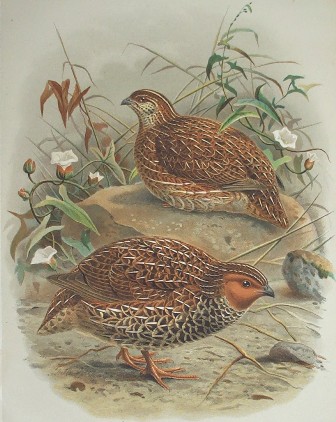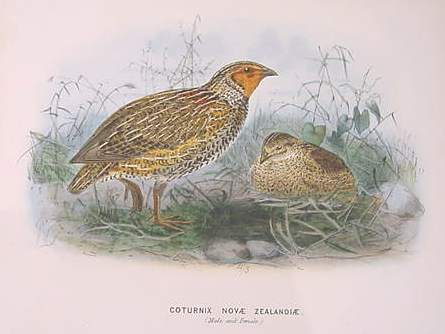
“Sir Joseph Banks in his Journal of Cook’s first voyage mentioned quail as having been seen in New Zealand in 1769 or 1770, and shortly afterwards, in 1772, Crozet found them to be very common at the Bay of Islands”, reports Oliver. “Forster reported them in Queen Charlotte Sound in May, 1773, during Cook’s second voyage. The first specimen to be obtained and described, however, was obtained in 1827 near the River Thames by Quoy and Gaimard, naturalists to the French exploring expedition under d’Urville, which visited New Zealand in the Astrolabe. About 1840, Dieffenbach in the North Island and P. Earl in the South Island reported the quail as not common. I can find no report of it ever being common in the North Island since Crozet’s time. It was taken at Whangarei in 1860 by Captain Mair and was last reported in Taranaki in 1869. In the South Island it was everywhere abundant until about 1865 when it suddenly decreased. The last specimens know to have been taken were those formerly in Buller’s collection obtained in Blueskin Bay in 1867 or 1868.
“All observers agree that the cause of the extinction of this quail was mainly fires which destroyed food and cover as well as the birds. Introduced mammals such as dogs, cats and rats were also contributory factors.”
Buller records that “it was excessively abundant in all the open country and especially on the grass covered downs of the South Island. The first settlers enjoyed some excellent quail shooting for several years and it is a matter of local history that Sir D. Munro and Major Richmond in 1848 shot as many as forty three brace in the course of a single day within a few miles of what is now the city of Nelson. While a Canterbury writer has recorded that in the early days, on the plains near Selwyn a bag of twenty brace of quail was not looked upon as extraordinary sport for a day’s shooting”.
Buller also records that according to Maori, even in the North Island it was formerly very abundant, certain grassy plains, like the Murimotu in the Taupo District being noted for them. Quail preserves were often given in the Maori Land court in support of title.
This extensive shooting for food and for sport undoubtedly caused severe reductions in the total population and there was also widespread burning off of the lowland tussock grassland which formed the birds main habitat. Their decline was sudden, over the course of a year or two, and in spite of the efforts of landowners to conserve the game by setting aside wide tracts of habitat, they became extinct around 1875.
Wairarapa, 2005.

Other common names: —
Description: —
Extinct bird
Adult male: top of head dark brown, upper face rufous brown varied with black and striped with white, primaries and outer secondaries dark brown, sides of face and throat rufous with narrow white shaft lines, dark band through the eye to the side of throat, lower neck mottled black and white, flanks rufous brown, abdomen white, bill black, iris hazel, feet pale flesh colour. Adult female: similar to male but lighter, no rufous colour on face or throat.
Where to find: —
Poetry: —
Whiti koreke, ka kitea kow!
Haere whakaparirau i a koe, haere whakamanu!
The quail springs up, you're found!
Go and get yourself wings, go and turn into a bird!
Illustration description: —
Buller, Walter Lawry, Birds of New Zealand, 1888.
Buller, Walter Lawry, Birds of New Zealand, 1873.
Reference(s): —
Oliver, W.R.B. New Zealand Birds, 1955.
Buller, Walter Lawry, Birds of New Zealand, 1888.
Page date & version: —
Thursday, 22 August 2019; ver2009v1

